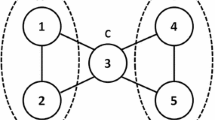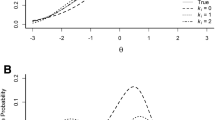Abstract
How critical is the concept of the latent trait to modern test theory? The appeal to some unobservable characteristic modulating response probability can lead to some confusion and misunderstanding among users of psychometric technology. This paper looks at a geometric formulation of item response theory that avoids the need to appeal to unobservables. It draws on concepts in differential geometry to represent the trait being measured as a differentiate manifold within the space of possible joint item response probabilities given conditional independence. The result is a manifest and in principle observable representation of the trait that is invariant under one to one transformations of trait scores. These concepts are illustrated by analyses of an actual test.
Similar content being viewed by others
References
Bock, R.D. and Aitkin, M. (1981). Marginal maximum likelihood estimation of item parameters: An application of an EM algorithm, Psychometrika, 46, 443–459.
Boothby, W.M. (1975). An Introduction to Differentiable Manifolds and Riemannian Geometry. Academic Press.
Douglas, J. (1995). Joint consistency of nonparmetric item characteristic curve and ability estimation, Psychometrika, in press.
Ellis, J.L. and Junker, B.W. (1995). Tail-measurability in monotone latent variable models. Carnegie-Mellon University, unpublished manuscript.
Fischer, G.H. (1995). Derivations of the Rasch model. In G.H. Fischer and I.W. Molenaar (Eds.) Rasch Models: Foundations, Recent Developments, and Applications. New York: Springer-Verlag.
Holland, P.W. and Rosenbaum, P.R. (1986). Conditional association and unidimensionality in monotone latent trait models. Annals of Statistics, 14, 1523–1543.
Junker, B.W. (1993). Conditional association, essential independence and monotone unidimensional item response models, Annals of Statistics, 21, 1259–1378.
Levine, M.V. (1984). An Introduction to Multilinear Formula Score Theory (Report 84-4). Champaign, IL: University of Illionois, Department of Educational Psychology, Model-Based Measurement Laboratory
Ramsay, J.O. (1991). Kernel smoothing approaches to nonparametric item characteristic curve estimation. Psychometrika, 56, 611–630.
Ramsay, J.O. (1995). A similarity-based smoothing approach to nondimensional item analysis. Psychometrika, 60, 323–339.
Author information
Authors and Affiliations
Corresponding author
About this article
Cite this article
Ramsay, J.O. A Geometrical Approach to Item Response Theory. Behaviormetrika 23, 3–16 (1996). https://doi.org/10.2333/bhmk.23.3
Received:
Published:
Issue Date:
DOI: https://doi.org/10.2333/bhmk.23.3




